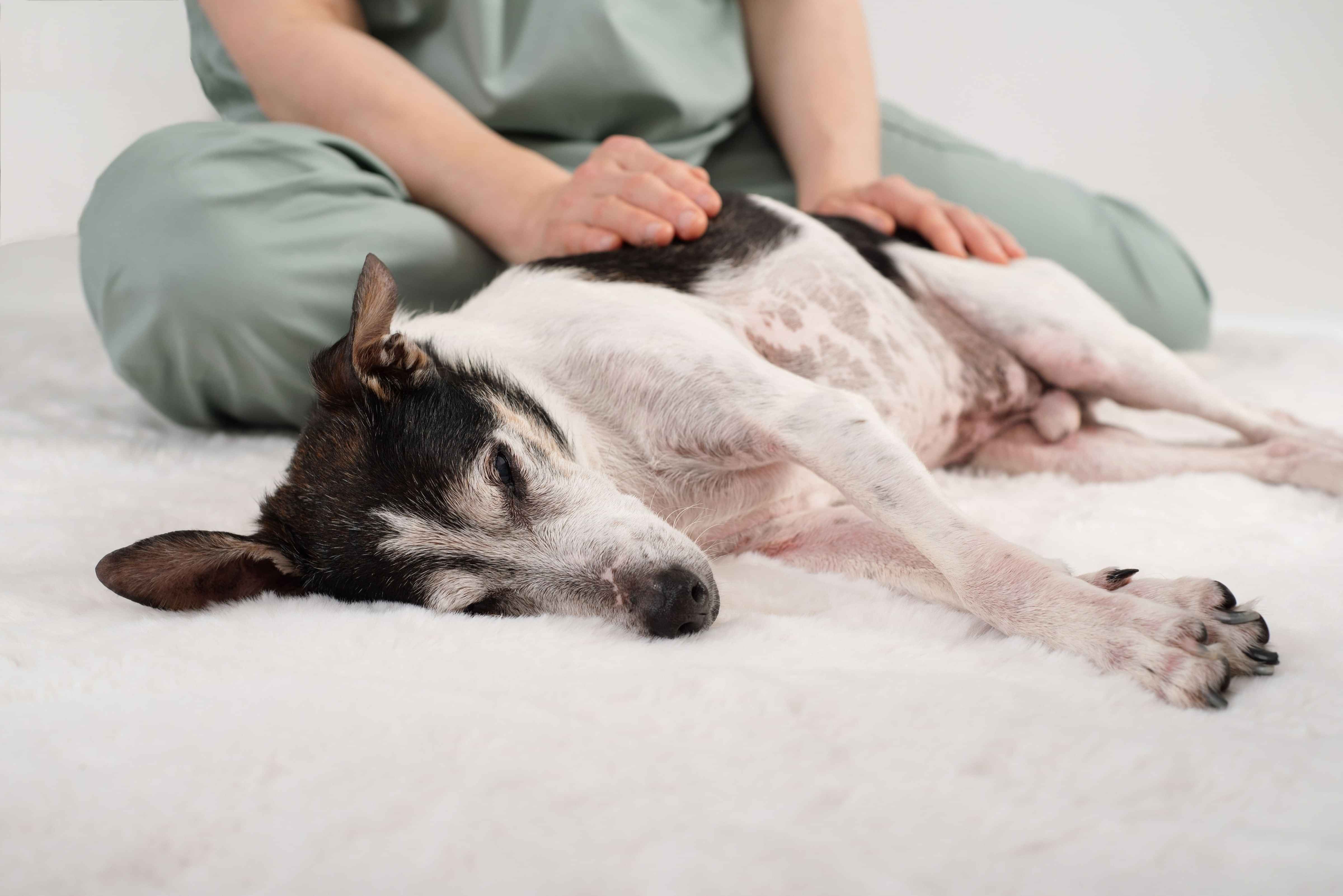Massage Therapy

Important note: Animal massage therapy is not a substitute for veterinary care. It is a complementary therapy modality that aims to take a holistic approach for physical, mental, and emotional wellness at any stage of dog’s life.
Therapeutic massage can be beneficial for dogs at any age. From a puppy to a senior dog, animal massage therapy offers a wide range of health benefits.
Below are just a few selected examples where massage can help your dog.
Building a positive association with a human touch is a very important part of a dog’s life. Have you adopted a dog from an animal shelter and your dog is not keen on human touch? Then, massage therapy can help your dog to learn how to accept a human touch safely.
Does your dog struggle to relax? Learning how to relax is an important step towards the dog’s mental wellbeing. Stress often leads to health issues. Massage therapy activates parasympathetic nervous systems, allowing deep relaxation. This promotes rest and healing of the dog’s body and mind.
Did your dog have a surgery or an injury recently? Massage therapy can help to speed up the recovery, reduce scarring, and minimise swelling. It improves blood circulation allowing more oxygen and nutrients to reach the tissues. It is useful in cases of localised oedema (swelling that is caused by body’s response to injury or interruption in tissues). Manual lymphatic drainage massage promotes and facilitates the flow of lymph while increasing activity of the lymphatic system as a whole. The technique is designed to mimic the pumping action of the lymph transport system.
Is your dog involved in agility or sport performance/competitions? Professional sport massage can result in an improved range of motion, decreased muscle tension, improved blood circulation that draws oxygen and nutrients to tissues. It promotes deep relaxation, release of endorphins, and gives the body a chance to rest and restore. By improving its physical and mental state the dog can be more focussed, energetic, and has less risk of injury.
Senior dogs may be suffering from a lack of mobility or have atrophies. Therapeutic massage can help to improve the range of motion, minimise pain, improve oxygenation and nutrient delivery to the areas that have been deprived of good blood circulation. It promotes the disposal of waste products from the cells. Therapeutic massage reduces the chance of further atrophy.
Have you experienced how painful trigger points can be? Did you feel how pain radiates to other areas of your body? Did you experience a relief from pain and a better range of motion when a massage therapist or physiotherapist released these trigger points? Our furry friends develop them too! If your dog has restriction or tension in the fascia (a connective tissue), this can directly affect the muscle function and movement. Fascia links muscles into specific lines or chains. Tightness or restriction in these lines can compress or irritate muscles. This can lead to the formation of myofascial trigger points and they, in turn, impact surrounding nerves and blood. These trigger points feel like nodules or hardened bands and they are often painful on compression and are characterised by radiating pain and tenderness along the corresponding facia line. Myofascial Trigger Point Therapy aims to release tension and adhesion in the tissue resulting in improved mobility, alleviation of pain, and promotion of tissue healing.
Does your dog suffer from injured tendons or ligaments? Orthopaedic friction massage technique, also known as cross-fibre friction/transverse friction was originally developed by British orthopaedic surgeon Dr. James Cyriax in 1940. It aims to address subacute and chronic adhesions and scar tissues by creating a controlled inflammatory response that triggers transportation of oxygenated blood rich in nutrients to the affected site. It is used to promote healing of injured tendons and ligaments. This technique helps to realign tissue, break down scar formations and adhesions, significantly reducing healing time, and enhances good mobility in soft tissues.
Unfortunately, dogs like humans get long-term illnesses or health conditions that requires end-of-life care. Massage and bodywork offer an improvement of quality of life and can (and should) be included in the palliative and/ or hospice care. Massage helps to reduce anxiety and stress. It promotes digestions and stimulates other systems, for example lymphatic, cardiovascular, and nervous systems, when the physical activity is limited. It helps with pain medication absorption and enhances the effects of other therapeutic modalities. It minimises compensatory pain and discomfort. It promotes mental stimulation. Regardless of the model for the palliative and / or hospice care selected, it is essential that the care team consists of people with complementary skills that address the animal’s needs and also those of their family members. It is about a holistic, integrative approach to care.
Canine massage benefits summary:
Promotes deep relaxation
Reduces stress
Enhances the immune system
Relieves sleep disturbance and restlessness
Builds a positive association with human touch
Prevents injuries in active / agility dogs
Improves blood and lymph circulation
Promotes metabolic waste disposal
Improves condition of skin and coat
Reduces swelling
Promotes healing of injured soft tissues
Reduces scarring
Releases painful trigger points
Promotes healthy muscle tone
Minimises atrophy
Improves joint flexibility
Massage Price List
Massage Therapy Appointment
1 hour
Full session of massage therapy
$120